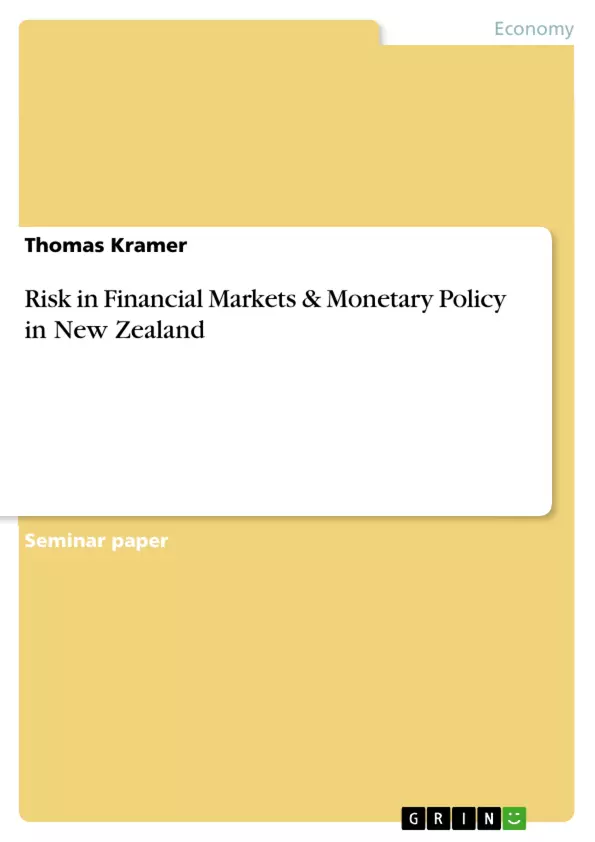Risk in financial markets becomes a major issue regarding financial transactions between parties in the market. "Risk in finance relates to the uncertainty of both the amount and timing of the future cash flows of a business or project". (Anonymous, no year)
It occurs when financial decisions have to be made with an amount of uncertainty about the pay-off of the financial transaction. This is because of insufficient knowledge about the other party involved in the transaction, which is called incomplete or asymmetric information. This lack of information makes it difficult to decide accurately and creates a problem on two fronts, before and after the transaction. (Mishkin, 2001, p. 34-35, 187)
Inhaltsverzeichnis (Table of Contents)
- Risk in Financial Markets...
- Asymmetric Information
- Transaction Costs
- Monetary Policy
- The Role of Monetary Policy in an Economy..
- The Operation of Monetary Policy in New Zealand
- The "Best Practice" in Monetary Policy
- New Zealand's Approach in Comparison to other Countries
- Concerns and Recommendations
- References
Zielsetzung und Themenschwerpunkte (Objectives and Key Themes)
This paper explores the complexities of risk in financial markets, focusing particularly on the impact of asymmetric information. It investigates the role of monetary policy in an economy, examining its implementation in New Zealand and comparing it to international best practices. The paper also analyzes the challenges and potential solutions associated with managing risk within these frameworks.
- Asymmetric Information and its implications for financial transactions
- The role of monetary policy in managing economic stability
- The impact of transaction costs on financial markets
- Comparative analysis of monetary policy strategies in different countries
- Identifying and mitigating risks associated with financial intermediation
Zusammenfassung der Kapitel (Chapter Summaries)
- Risk in Financial Markets: This chapter introduces the concept of risk in financial transactions, highlighting the significance of asymmetric information. It explores the problems of adverse selection and moral hazard, which arise from incomplete information about borrowers and their potential actions.
- Asymmetric Information: This section delves into the problem of adverse selection, outlining its occurrence before a transaction and its potential consequences. It discusses countermeasures such as information production and government regulation but acknowledges their limitations. The chapter highlights the role of financial intermediaries in mitigating this issue by acting as experts in screening borrowers and providing private loans.
- Transaction Costs: This section focuses on the challenges posed by transaction costs, including the information gathering, negotiation, and monitoring involved in financial transactions. It explores the implications of these costs for both individuals and businesses, highlighting the importance of efficient financial intermediaries in minimizing these burdens.
- Monetary Policy: This chapter examines the role of monetary policy in managing economic stability. It defines the objectives of monetary policy, such as controlling inflation and maintaining employment levels, and explores the tools used by policymakers, including interest rate adjustments and reserve requirements.
- The Role of Monetary Policy in an Economy..: This section delves into the specific objectives and functions of monetary policy within an economy. It discusses the trade-offs faced by policymakers, such as the potential for inflation versus unemployment, and explores the different schools of thought regarding the best approach to monetary policy.
- The Operation of Monetary Policy in New Zealand: This section provides a detailed analysis of how monetary policy is implemented in New Zealand. It examines the specific tools used by the Reserve Bank of New Zealand, such as the official cash rate, and evaluates the effectiveness of these policies in achieving their intended outcomes.
- The "Best Practice" in Monetary Policy: This chapter explores international best practices in monetary policy, comparing the approaches of different countries and highlighting successful strategies. It examines the role of central banks in maintaining price stability, promoting economic growth, and managing financial risks.
- New Zealand's Approach in Comparison to other Countries: This section compares New Zealand's monetary policy framework to that of other countries, evaluating its strengths and weaknesses. It analyzes the impact of global economic developments on New Zealand's monetary policy decisions and discusses potential areas for improvement.
- Concerns and Recommendations: This section identifies potential concerns and challenges associated with risk in financial markets and the implementation of monetary policy. It proposes recommendations for improving the effectiveness of these frameworks, ensuring financial stability, and promoting economic growth.
Schlüsselwörter (Keywords)
This paper examines the concepts of asymmetric information, adverse selection, moral hazard, transaction costs, and financial intermediation. It explores the role of monetary policy in managing economic stability, including its objectives, tools, and implementation in New Zealand and other countries. Key themes include the challenges of managing risk in financial markets, the importance of effective financial intermediaries, and the trade-offs inherent in monetary policy decisions.
- Citar trabajo
- Thomas Kramer (Autor), 2000, Risk in Financial Markets & Monetary Policy in New Zealand, Múnich, GRIN Verlag, https://www.grin.com/document/1900



